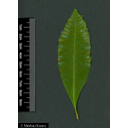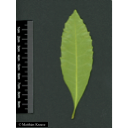Useful information about the taxon (species, subspecies, variety...)
Myrica faya Dryand. 1789
Myricaceae
(APG IV)firetree, fayatree, candleberry myrtle
Taxon concept: The Plant List (2010)
Distribution: Canary Islands, Azores, Madeira Islands; introduced to Hawaii, New Zealand, Australia
Size: 4 - 16 (m)
Myrica faya Dryand. - Accepted: Myrica faya Dryand. bei The Plant List (2010); Familie: Myricaceae (APG III)Myrica faya Dryand. - Accepted: Myrica faya Dryand. bei The Plant List (2014), version 1.1; Familie: Myricaceae (APG III)Myrica faya Dryand. - Accepted: Myrica faya Dryand. bei The Plant List (2014), version 1.1; Familie: Myricaceae (APG IV)
- Flowers
- subdioecious; flowers in branched catkins
- Flower ecology
- wind-pollinated (anemophilous)
- Life form
- shrub or small tree
- Leaves
- leaves alternate, oblanceolate, coriaceous, shiny, dark green, aromatic, 4-12 cm long, cuneate at the base, apically often toothed, margins somewhat revolute
- Foliage persistence
- evergreen
- Fruit ecology
- bird-dispersed (ornithochorous)
- Soil conditions
- on moist volcanic soils
- Natural occurrence (habitat)
- laurel forests, cliffs, coastal shrubland, Myrica-Picconia* woodland, degraded forests, on lava flows, pasture margins, along roadsides, hedgerows, margins of agricultural fields
- Comment to ecology
- actinorrhizal nitrogen fixer; invasive species; litter has allelopathic effects
- Vegetation typ and synecology (plant community)
- subtropical, broad-leaved evergreen, humid laurophyllous forests (laurisilva); in communities of the fayal-brezal (heath scrub), e.g. in association with Picconia azorica (Tutin) Knobl. (White Wood)
- Constraints according radiation (light)
- relatively shade-intolerant
- Usage
- as ornamental plant; as medical plant used for treatment of catarrh; the drupes can be used for making marmelade; in the USA cultivated as a bionenergy plant
- Phytopathogenic organisms
- is affected by a number of diseases and pests, e.g. by the moth Caloptilia sp. nr. schinella
- Altidudinal lower limit (sea level in m)
- 0
- Altitudinal higher limit (sea level in m)
- 1,500
Beck, P. et al. (2016): Betula pendula, Betula pubescens and other birches in Europe: distribution, habitat, usage and threats. In: San-Miguel-Ayanz, J., de Rigo, D., Caudullo, G., Houston Durrant, T., Mauri, A. (Eds.). European Atlas of Forest Tree Species. Publication Office of the EU, Luxembourg.; Erhardt, W., Götz, E., Bödeker, N. & Seybold, S. (2008): Der große Zander. Enzyklopädie der Pflanzennamen. Band 2. Arten und Sorten. Eugen Ulmer KG, Stuttgart (Hohenheim), 18. Aufl., 2103 S.; Global Biodiversity Information Facilty (GBIF). Online Publication: www.gbif.org;
Diese Webseite verwendet Google Maps, um Karten und Standorte von Pflanzen in den Hohenheimer Gärten anzuzeigen. Dadurch werden unter Umständen Daten an Google weitergeleitet, was mit einer Verarbeitung Ihrer personenbezogenen Daten verbunden sein kann. Die Datenschutzerklärung von Google finden Sie hier: Datenschutzerklärung von Google
| Sex | Standort | Accession number | Planting year | Donation | IPEN | Lat. | Long. |
|---|---|---|---|---|---|---|---|
| Kübelpflanze | SYS-K-10989 | XX-0-HOH-SYS-K-10989 | 48,708524 | 9,210506 |


